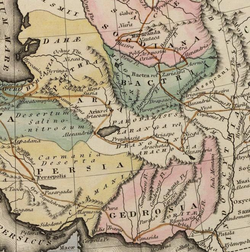Gedrosien
Gedrosien (Gedrosia) is the ancient name of a barren mountain region in the south of today 's Iran and Pakistan , which is one of the driest on earth. It bordered on the south by the Gulf of Oman in the east to the Indus valley , north to Arachosia and whistles Gianien and to the west Carmania .
history
Gedrosien was among other things a satrapy of the Achaemenid Empire and was traversed by Alexander the Great when he returned from his Indian campaign. He was in the autumn of 325 BC. With an army of about 20,000 men, consisting of selected Macedonian units and mounted archers, set out from Pattala and first crossed the eastern Gedrosien. There he met the Indian people of the Arabites and then the Persian tribe of the Orittens , whom he fought because of their hostile attitude. As a result, he had Ora, the capital of the Oreiten, converted into a Macedonian colony and appointed Apollophanes as satrap of Gedrosiens. The general Leonnatos , who remained with part of the army in the Oreit area, was supposed to support Apollophanes, among other things, with the rebuilding of Ora. He was able to suppress an uprising of the Oreitmen, but Apollophanes fell in the fighting.
Meanwhile Alexander had moved on. He wanted to stay along the coast of Gedrosia in order to stay in contact with his following fleet and to establish bases for them. To the west of Kokala , however, he came across the Taloi coastal mountains and therefore had to turn inland. He crossed the Tomeros River (today Hungol ) and came to a desert-like area that could only be crossed with extreme effort. In places there was also vegetation, and among other things myrrh resin was extracted here . It also mentions the occurrence of snakes, against whose bites Alexander consulted Indian doctors. Victims of snakebites should report to his tent. During the desert march, which took place from about September to November 325 BC. Was carried out, the weather was very hot, which, in combination with a lack of water, led the Macedonian king to march only at night. He forbade his men from eating mango because they suffered from diarrhea . Due to the increasing shortage of food, the soldiers broke up grain stores that had been intended for the crew of the fleet. They also slaughtered draft animals. After all, a lot of baggage and booty had to be left behind. The sick and exhausted also died on the way. During a downpour, a torrent flooded the army camp and claimed deaths. When a soldier offered Alexander a helmet full of water, the king poured it out with the remark that he did not want to have his companions ahead of him.
The Macedonian king was aware of his responsibility and, according to the ancient reports, looked ashamed and worried. He ordered the south-westerly course to be kept as the direction of march in order to reach the seashore again. The local guides lost their way, whereupon Alexander looked for the right route even with a few men. He chose the southern direction and finally came across the coast near Patni. Potable groundwater could be dug here. The army now had the opportunity to regroup and, after another 320 km march, arrived in Pura , the capital of Gedrosia. Overall, the loss-making desert march from Ora to Pura took 60 days.
The reason that the conceived on the way back from India to Persia Alexander had chosen the dangerous route through the gedrosische desert was probably the fact that it is the shortest route from the mouth of the Indus to Carmania was to go from there to the Persis to reach. In addition, the legends that reported about the arduous desert crossings undertaken by Semiramis and Cyrus the Great were perhaps an incentive for him .
In Islamic times, that is, in the Middle Ages, the inaccessible region inhabited by nomadic desert peoples was known as Makran ; later the name Balochistan became common.
literature
- Aurel Stein : On Alexander's Route into Gedrosia: An Archaeological Tour in Las Bela. In: The Geographical Journal. Vol. 102, No. 5/6, 1943, ISSN 0016-7398 , pp. 193-227, doi : 10.2307 / 1789131 .
Remarks
- ^ Siegfried Lauffer : Alexander der Große , dtv, 3rd edition Munich 1993, ISBN 3-423-04298-2 , p. 160.
- ↑ Arrian , Anabasis 6, 21, 3-22, 3; Curtius Rufus , Historia Alexandri Magni 9, 10, 6 f .; Diodor , Bibliothḗkē historikḗ 17, 104, 4 - 105, 2.
- ↑ a b Arrian, Anabasis 6, 23, 1.
- ^ Siegfried Lauffer, Alexander the Great , p. 161.
- ↑ Alexander Demandt : Alexander the Great. Life and legend. CH Beck, Munich 2009, ISBN 978-3-406-59085-6 , p. 325.
- ↑ Arrian, Indicé 15, 11.
- ^ Theophrast , Historia plantarum 4, 4, 5.
- ↑ Arrian, Anabasis 6, 23, 4 f.
- ^ Curtius Rufus, Historia Alexandri Magni 9, 10, 14 ff.
- ↑ Arrian, Anabasis 6, 25, 5 f.
- ↑ Arrian, Anabasis 6, 26, 1 ff.
- ↑ Arrian, Anabasis 6, 25, 2; Curtius Rufus, Historia Alexandri Magni 9, 10, 17; Diodor, Bibliothḗkē historikḗ 17, 105, 6.
- ↑ Arrian, Anabasis 6, 26, 4 f.
- ↑ Arrian, Anabasis 6, 27, 1; Curtius Rufus, Historia Alexandri Magni 9, 10, 18; Diodor, Bibliothḗkē historikḗ 17, 106, 1; Plutarch , Alexander 66, 7-67, 1.
- ↑ Arrian, Anabasis 6, 24, 2 f .; Strabon , Geographika 15, p. 686 and 722 (after Nearchus ); on this Alexander Demandt, Alexander the Great , p. 324.
